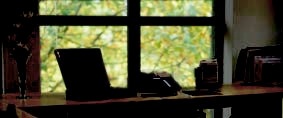Contrast Ratio
Contrast Ratio refers to the range of both light and dark images that can be seen (or that a camera can reproduce).
The human eye is very good at seeing detail in both bright and dark things at the same time. The eye's contrast ratio is approximately 1000:1. That means, for example, a person can look out a window and see detail in the outside scene AND detail in the room simultaneously--even though the outside is 1000 times brighter (on a sunny day, it really is 1000 times brighter).
A camera cannot handle such a range. Going back to the window scene--if the exposure is set to see detail outside, the inside will be a silhouette. If it is set for the inside, the outside will be washed out.
Since the aperture can be adjusted for one or the other, in this scene it would be up to the filmmaker to decide what is important.

This is the scene as your eyes see it. Notice how there is detail in BOTH the outside trees AND the items on the desk--despite a major brightness differential.

This is what a typical camera sees because it can't handle the brightness differential. If the exposure is set for the items on the desk; then the trees--which are MUCH brighter--just go completely white.

Adjusting the exposure of the camera for the trees means everything on the desk becomes too dark.

